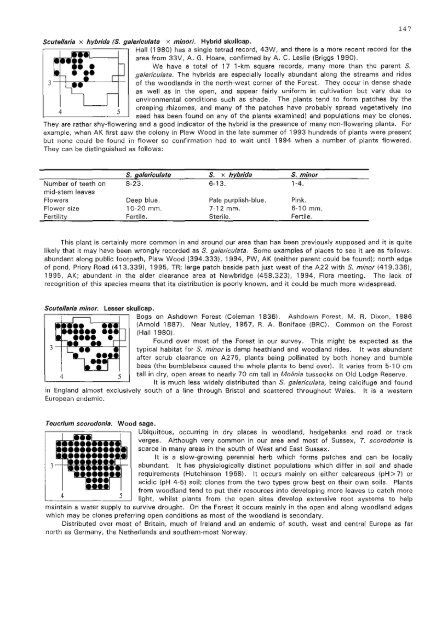Flora of Ashdown Forest - Botanical Society of the British Isles
Flora of Ashdown Forest - Botanical Society of the British Isles
Flora of Ashdown Forest - Botanical Society of the British Isles
You also want an ePaper? Increase the reach of your titles
YUMPU automatically turns print PDFs into web optimized ePapers that Google loves.
5cutellaria x hybrida (5. galericulata x minor). Hybrid skullcap.Hall (1980) has a single tetrad record, 43W, and <strong>the</strong>re is a more recent record for <strong>the</strong>area from 33V, A. G. Hoare, confirmed by A. C. Leslie (Briggs 1990).We have a total <strong>of</strong> 17 1-km square records, many more than <strong>the</strong> parent S.galericulata. The hybrids are especially locally abundant along <strong>the</strong> streams and rides<strong>of</strong> <strong>the</strong> woodlands in <strong>the</strong> north-west corner <strong>of</strong> <strong>the</strong> <strong>Forest</strong>. They occur in dense shadeas well as in <strong>the</strong> open, and appear fairly uniform in cultivation but vary due toenvironmental conditions such as shade. The plants tend to form patches by <strong>the</strong>creeping rhizomes, and many <strong>of</strong> <strong>the</strong> patches have probably spread vegetatively (no4 5seed has been found on any <strong>of</strong> <strong>the</strong> plants examined) and populations may be clones.They are ra<strong>the</strong>r shy-flowering and a good indicator <strong>of</strong> <strong>the</strong> hybrid is <strong>the</strong> presence <strong>of</strong> many non-flowering plants. Forexample, when AK first saw <strong>the</strong> colony in Plaw Wood in <strong>the</strong> late summer <strong>of</strong> 1993 hundreds <strong>of</strong> plants were presentbut none could be found in flower so confirmation had to wait until 1994 when a number <strong>of</strong> plants flowered.They can be distinguished as follows:147Number <strong>of</strong> teeth onmid-stem leavesFlowersFlower sizeFertility5. galericulata8-23.Deep blue.10-20 mm.Fertile.S. x hybrida6-13.Pale purplish-blue.7-12 mm.Sterile.S. minor1-4.Pink.6-10 mm.Fertile.This plant is certainly more common in and around our area than has been previously supposed and it is quitelikely that it may have been wrongly recorded as S. galericulata. Some examples <strong>of</strong> places to see it are as follows:abundant along public footpath, Plaw Wood (394.3331. 1994, PW, AK (nei<strong>the</strong>r parent could be found); north edge<strong>of</strong> pond, Priory Road (413.339), 1995, TR; large patch beside path just west <strong>of</strong> <strong>the</strong> A22 with S. minor (419.336),1995, AK; abundant in <strong>the</strong> alder clearance area at Newbridge (458.3231. 1994, <strong>Flora</strong> meeting. The lack <strong>of</strong>recognition <strong>of</strong> this species means that its distribution is poorly known, and it could be much more widespread.5cutellaria minor. lesser skullcap.Bogs on <strong>Ashdown</strong> <strong>Forest</strong> (Coleman 1836). <strong>Ashdown</strong> <strong>Forest</strong>, M. R. Dixon, 1886(Arnold 1887). Near Nutley, 1957, R. A. Boniface (BRC). Common on <strong>the</strong> <strong>Forest</strong>(Hall 1980).Found over most <strong>of</strong> <strong>the</strong> <strong>Forest</strong> in our survey. This might be expected as <strong>the</strong>3 typical habitat for S. minor is damp heathland and woodland rides. It was abundantafter scrub clearance on A275, plants being pollinated by both honey and bumblebees (<strong>the</strong> bumblebees caused <strong>the</strong> whole plants to bend over). It varies from 5-10 cm4 5 tall in dry, open areas to nearly 70 cm tall in Molinia tussocks on Old Lodge Reserve.It is much less widely distributed than S. galericulata, being calcifuge and foundin England almost exclusivelY south <strong>of</strong> a line through Bristol and scattered throughout Wales. It is a westernEuropean endemic.Teucrium scorodonia. Wood sage.Ubiquitous, occurring in dry places in woodland, hedge banks and road or trackverges. Although very common in our area and most <strong>of</strong> Sussex, T. scorodonia isscarce in many areas in <strong>the</strong> south <strong>of</strong> West and East Sussex.It is a slow-growing perennial herb which forms patches and can be locallyabundant. It has physiologically distinct populations which differ in soil and shaderequirements (Hutchinson 1968). It occurs mainly on ei<strong>the</strong>r calcareous (pH> 7) oracidic (pH 4-5) soil; clones from <strong>the</strong> two types grow best on <strong>the</strong>ir own soils. Plantsfrom woodland tend to put <strong>the</strong>ir resources into developing more leaves to catch morelight, whilst plants from <strong>the</strong> open sites develop extensive root systems to helpmaintain a water supply to survive drought. On <strong>the</strong> <strong>Forest</strong> it occurs mainly in <strong>the</strong> open and along woodland edgeswhich may be clones preferr'lng open conditions as most <strong>of</strong> <strong>the</strong> woodland is secondary.Distributed over most <strong>of</strong> Britain, much <strong>of</strong> Ireland and an endemic <strong>of</strong> south, west and central Europe as farnorth as Germany, <strong>the</strong> Ne<strong>the</strong>rlands and sou<strong>the</strong>rn-most Norway.
















